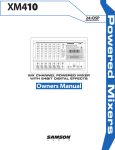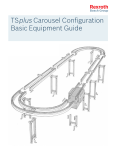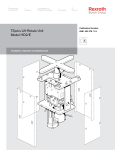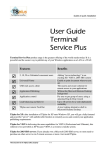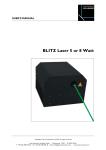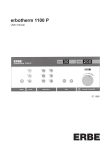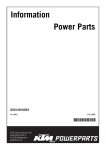Download Bosch Rextroth TSplus Operating instructions
Transcript
Modular Transfer Systems TSplus Lift-Transfer Unit Model EQ2/U3 Installation and Maintenance Publication Number: 8981 500 299 7/02 Lift-Transfer Unit 2 Table of contents IMPORTANT SAFETY INFORMATION .................. 3 For Lift And Lower Operation.................................. 14 Safety First ................................................................. 3 For Lift Only Operation ............................................. 14 Material Hazards: ...................................................... 3 Stop Rail Orientation ................................................. 16 Review All Safety Information: ............................... 3 Cushioned Stop Pneumatic Diagram .................... 16 IMPORTANT SAFETY INFORMATION .................. 4 Installing Optional Cushioned Stop BWT = 480 and smaller ........................................... 17 SAVE THESE INSTRUCTIONS ............................... 4 Introduction .................................................................... 5 Installing Optional Cushioned Stop BWT = 640 ................................................................. 17 About this manual ......................................................... 5 Operating Instructions .............................................. 18 Design and Detailed Description ............................. 6 Maintenance ................................................................ 19 Application and Function ............................................ 7 Repair ............................................................................ 20 Using T-Bolts and T-Nuts ........................................... 8 Replacing the Toothed Belt ..................................... 20 Attach LTU to Conveyor Section ............................. 9 Replacing Gear Box .................................................. 22 Installing Proximity Switch ........................................ 10 Installation of Protective Covers ............................. 25 Checking and Adjusting Toothed Belt Tension .. 11 Scope of Delivery ................................................... 25 Initial Start-up .............................................................. 12 Step by Step Assembly Instructions .................. 26 Connect the motor wiring ......................................... 12 Module Warranty ........................................................ 28 For CE Applications................................................... 13 Liability .......................................................................... 28 Terminal Block Assembly Instructions .................. 13 Environmental Protection ......................................... 28 Connect the Compressed Air Supply ................... 14 All rights are held by BOSCH AUTOMATION PRODUCTS and ROBERT BOSCH GMBH, also regarding patent claims. We retain all powers of disposition, such as for copying and/or for passing-on to third parties. We reserve the right to make technical changes at any time without notice. Errors and omissions excepted. © 2002 Bosch Automation Products 3 IMPORTANT SAFETY INFORMATION IMPORTANT: This operation and installation manual should be reviewed with all equipment operators as part of your operator training program. SAFETY FIRST! Important safety information is contained throughout this manual to alert you to potentially dangerous situations and help prevent accidental injury and property damage. The safety warning symbol above has been included to warn you of hazards that can hurt or kill you and others, and/or cause serious damage to the equipment and other property. In addition, the following safety alert words are used: DANGER! Means that you or others will be seriously or fatally injured if instructions are not followed. WARNING! Means that you or others may be seriously or fatally injured if instructions are not followed. CAUTION! Means that you or others may be injured if instructions are not followed. Material Hazards: Some components, such as gearboxes, contain lubricants or other materials that can represent a potential health hazard if handled, stored, or disposed of improperly. Please contact Bosch for copies of the Material Safety Data Sheets (MSDS) for the lubricating oil used in gearboxes and other potentially hazardous materials. Review All Safety Information: Please review the safety information included on page 4 and throughout this manual with all installers, operators, and maintenance personnel of this equipment. 4 IMPORTANT SAFETY INFORMATION WARNING! Please read all assembly, and maintenance instructions carefully before beginning set-up of the components in this document. Where appropriate, warning symbols have been included in this publication to alert you of potential or impending danger. • Be sure to read and observe all safety warnings in this document as well as those attached to the individual modules. Failure to do so could result in potential risks to your health and safety as well as those around you. • Covers and guards have been designed to eliminate pinch points and exposure to moving chains and gears. DO NOT operate the conveyor or any of the other components in the system with the guards removed. Serious injury may result! • All set-up maintenance and repair work should be performed only by properly trained, qualified personnel. All operators must be properly trained in the use of this equipment. • A qualified electrician must make all electrical connections when wiring the components installed in the TSplus system. Be sure to follow all local, state and federal regulations when installing electrical devices of any type. The customer assumes responsibility for the control system, and must provide an EMERGENCY-OFF SWITCH or switches for all workstation operators to meet all applicable industry and OSHA requirements. In general, emergency-off switches must be present at easily accessible locations for all operators of the installed TSplus conveyor system. • All power supplies must be LOCKED OUT before beginning maintenance or repair work of any type on the conveyor system. Proper LOCK OUT procedures include the identification of the locked out power supply with a tag to prevent the accidental restoration of power. • TSplus pneumatic components are designed to operate in a range of 4–6 Bar (58–87 psi). It is the users responsibility to install a filtered, regulated air supply to limit the pressure to that recommended by the manufacturer. Before beginning any maintenance or repair, bleed off the pressure lines to all components to prevent unexpected or accidental movement of a system component which could result in personal injury. • TSplus drives, returns and conveyor sections and components are designed to transport Bosch WT2, WT2/A, WT2/A-H workpiece pallets. Proper usage is defined as the transport and positioning of parts and assemblies via the workpiece pallet and fixture during the assembly process. In no instances should the pallet payload, the downward force applied to the pallet, or the total load carrying capacity of the entire system be exceeded. Exceeding published specifications will result in premature wear or system failure and may cause damage to the motor, gearbox, roller chain, seals and other components. • CAUTION! Do not operate or work near mechanical equipment when wearing loose clothing. Moving components such as roller chain, drive belts, drive shafts and pallets can snag long belts, scarves, ties and other loose fitting garments, pull the worker into the equipment and cause serious, or in extreme cases, life threatening injury. • CAUTION! Operators having long hair must wear appropriate head protection (hair nets, hats, and hair caps) to minimize the risk associated with working near moving machinery. Hanging hair can get caught in moving components such as roller chain, drive belts, drive shafts and pallets, pull the worker into the equipment and cause serious, or in extreme cases, life threatening injury. SAVE THESE INSTRUCTIONS! 5 Introduction Like all Bosch flexible assembly systems, TSplus is constructed solely from standardized modules that are precisely matched to each other. One important benefit of this modular design is that you can interlink manual and automatic work stations freely, making TSplus suitable for virtually any assembly task. The EQ2/U3 Lift Transfer Unit (LTU) module allows you to transfer pallets laterally off of the main conveyor line. This manual describes the primary components that make up the EQ2/U3 Lift Transfer Unit (refer to page 6 for a description of primary components and their functions). Other TSplus modules are also available and vary according to the configuration of the system. These modules are described in separate manuals and include the following: About this manual The manual is divided into the following sections to make it easier to use: • Design and Detailed Description Supplies an overview of the modules that make up the EQ2/U3. This section will familiarize you with the modules individual components. • Drives, Returns, and Conveyor Sections • Cushioned and Standard Stop Gates, Rockers • Proximity Switch Mounting Kits • Accumulation Control Kits • Lift-Position Units • Application and Function Gives general information about the EQ2/U3 Tandem Lift Transfer Unit. • Lift-Rotate Units • Curve Modules • Technical Data Provides the most important technical specifications. • Assembly Lists step-by-step instruction for installing the EQ2/U3 . • Initial Start-up Describes the final procedures for getting the EQ2/U3 up and running. • Maintenance Provides information on preventive maintenance. • Repair Gives step-by-step procedures for replacing any parts subjected to wear. Contact Bosch for information on these and any other modules for flexible assembly. If this module was ordered as CE compliant, please contact our applications engineering department for a copy of the latest manufacturer's CE declaration. 6 Design and Detailed Description The EQ2/U3 includes a drive motor to power the toothed belts, two spring centered 3-position pneumatic cylinders, stop bar/guide bar, protective covers, pneumatic connections and mounting hardware. A proximity switch mounting bracket is also included. Due to the stroke, all three positions may not be sensed, as three proximity switches will not fit into the space available. It is recommended that the center “pallet stop position” be sensed and the signal lost on the up and down strokes. The proximity switch mounting kit can also be ordered separately under part number: 3842 311 894. In the EQ2/U3 (Fig. 1), the motor and gearbox power the toothed belt conveyor via the belt drive gears. Double acting pneumatic cylinders on the LTU may be configured to lower the toothed belt conveyors below the transport surface to allow pallet passthrough, or raise the pallet on the toothed belt conveyors above the transport surface. In the raised position, the toothed belts transfer the pallet across a track roller section or transverse conveyor onto the receiving LTU. The pneumatic cylinders on the receiving LTU then exhaust and lower the pallet to the transport surface of the parallel line. A protective cover protects the mechanism of the LTU from dirt and damage and helps prevent accidental injury. Proximity switches may be mounted to detect raised or lowered status of the LTU. CAUTION! DO NOT operate the EQ2/U3 with the protective cover removed! Serious injury may result if the EQ2/U3 is operated without guards! 3-Position Pneumatic Cylinders Stop Bar Toothed Belt Conveyor T-Bolt Muffler Drive Motor Protective Cover Fig. 1 7 Application and Function The EQ2/U3 Lift Transfer Unit (LTU) is used to transfer pallets perpendicularly off the conveyer. It is used primarily at “corners” and “intersections”, but can also be used for pallet routing changes. “Corner Transfer” requires LTU operation in the “Pallet Stop” and “Transfer” positions as shown. Optional Cushioned “Intersection Transfer” requires LTU operaStop tions in the “Pallet Stop”, “Transfer” and “Clear” positions as shown. Intersection Transfer permits the pallet to be directed off the main line or allows the pallet to pass through depending on the process requirement. The LTU lift plate is powered up and down by two pneumatic cylinders. In the spring centered, “Pallet Stop” position, the LTU belts are located 1 mm below the bottom of the pallet. A stop bar mounted to the lift plate may be used to stop pallets on the LTU, or inverted so pallets pass through freely. An optional cushioned stop may be installed when pallet payloads exceed 30 kg or with transport speeds of 12 m/min or greater. Rocker Stop “Corner Transfer” “IntersectionTransfer” 1 mm Centered “Pallet Stop” Position 10 mm Raised “Transfer” Position The LTU is raised to the “Transfer Position” by applying air pressure to the bottom of the cylinders. This lifts the LTU to a position 10 mm above the nominal conveyor height. As the LTU rises, the LTU belts engage the pallet and directs (or accepts) the pallet. 11 mm The LTU is lowered to the “Clear Position” by applying air pressure to the top of the cylinders. This pushes the LTU down to a position 11 mm below the nominal conveyor height. Use the lowered position when it is required to allow pallet pass through on the main conveyor at spur lines and test stations for example. Lowered “Clear” Position 8 Operation (Fig. 2) Pallet transfer from one parallel line to an adjacent line requires the use of a sending EQ2/U3 and a receiving EQ2/U3 located at each end of a set of track rollers or a transverse conveyor. The sending LTU waits in “Pallet Stop” mode below the transport surface level until a pallet passes over the LTU and is stopped by the stop rail or a cushioned stop triggering a proximity sensor that activates the LTU. The pneumatic cylinders in the LTU then energize, lifting the pallet perdendicularly off the main line, across the non-powered track rollers or powered transverse conveyor, and onto the waiting LTU. The waiting LTU then lowers the pallet back to the transport surface of the parallel line. Sending Lift Transfer Unit Receiving Lift Transfer Unit Pallet Flow Track Rollers or Transverse Conveyor Fig. 2 Using T-Bolts and T-Nuts A The EQ2/U3, like virtually all Bosch conveyor modules, is connected to the transfer system using the Tslot principle (Fig. 3). Insert the T-bolt into slot (A), and tighten down the hex nut. As it tightens, it will turn the T-bolt 90° in the slot (B), creating a friction lock (C). The same principle applies to T-nuts. The maximum allowable torque is 25 Nm (18.5 ft-lbs). B ASSEMBLY TIP: T-Bolts also have a mark on the end of the threaded shaft that will be perpendicular to the T-slot when the T-Bolt is in its locked position. C Fig. 3 Mark 9 Attach LTU to Conveyor Section (Fig. 4 and 5) 1 Mark the location on the conveyor line where the LTU is to be installed. conveyor section profile SP/2. Hand tighten the M8 flange nut. 6 Attach supporting bar to mounting brackets using hardware previously removed. 2 Remove middle guard cover. 3 Remove mounting brackets (2 per side) from supporting bar on LTU and install in T-slot on conveyor section profiles. 4 Lower EQ2/U3 from above onto conveyor section profiles and set down on the four brackets. Adjust bracket position if necessary. 5 Manually insert four M8 T-bolts with the T-heads through the oblong holes in the T-slot of the 7 Check alignment. (Fig. 5) NOTE: Use a straightedge to be sure that the Lift Transfer Units and track rollers are in perfect alignment from side-to-side, as shown in Fig. 5. This is critical for pallet transfer. 8 Tighten the M8 flange nuts to 25 Nm (19 lb-ft). Middle Guard Cover Sending Lift Transfer Unit Conveyor Section Profile Supporting Bar Pallet Flow T-slot M8 Flange Nut M8 T-bolt Mounting Brackets Fig. 4 T-groove Conveyor Section Profile Fig. 5 Straight Edge Receiving Lift Transfer Unit Track Rollers or Transverse Conveyor 10 Installing Proximity Switch (Fig. 6) 1 Install the proximity switch in the mounting bracket so that the sensing distance is approximately 2 mm (see inset). NOTE: Due to the stroke, all three positions can not be sensed, as three proximity switches will not fit into the space available. It is recommended that the center “Pallet Stop” position be sensed and the signal lost on the up and down stroke. Proximity Switch Exciter Proximity Switch Mounting Bracket 2 mm Proximity Switch Fig. 6 11 Checking and Adjusting Toothed Belt Tension NOTE: Incorrect toothed belt tension can lead to premature belt failure! Always check toothed belt tension prior to initial operation! Using a moderate amount of pressure, press upward on the belt for a deflection of approximately 10 mm (see inset 2) . To re-tension the toothed belt, loosen the 5 mm socket head cap screw on the return roller (see inset 1). Then using a pry bar (screwdriver) move the return roller upward until the belt can be deflected, using a moderate amount of pressure, approximately 10 mm (see inset 2). Retighten the socket head cap screw. Recheck tension. Toothed Belt Return Roller INSET #1 Pry Bar 5 mm Socket Head Cap Screw "Z" INSET #2 Fig. 7 12 Initial Start-up For CE applications, refer to the next page for instructions on installing and connecting the terminal block. Before starting up the Lift Transfer Unit for the first time, recheck all mounting hardware for tightness. Delta Connection (Low Voltage) L2 (Blk/Yel)T4 T2 (Blu) NOTE: The customer assumes responsibility for the control system, and must provide an EMERGENCYOFF SWITCH in the EQ2/U3. T5(Blu/Yel) (Blk) T1 T3 (Red) (Red/Yel) T6 Connect the motor wiring Grn/Yel TR (Gnd) Make the motor electrical connections according to the connection schematic as shown (see Fig. 8) . An additional copy is also attached to the motor nameplate. NOTE: All electrical wiring must be connected by a qualified electrician. “Y” Connection (High Voltage) T2 T5 T6 T4 T1 Blu L2 Star Splice (Blk/Yel, Blu/Yel Red/Yel) T3 Red Blk Grn/Yel TR (Gnd) Fig. 8 L3 L1 L3 L1 13 For CE Applications If a CE compliant module was ordered, an optional terminal block (Fig. 9) was included. Refer to the terminal box mounting instructions included with the terminal box. Blue #4-40 Screw Orange #4-40 Screw Terminal Block Assembly Instructions 1. Attach the terminal box to the motor according to the mounting instructions included with the terminal box. See Fig. 9. 2 Assemble the terminal block components to produce an assembly having the following order: support block, beige middle, blue middle block, orange block and beige end block. See Fig. 9. 3 Secure the terminal block assembly to the terminal box using two #4-40 screws in the position shown. Tighten in the range 3 to 5 lb-in. 5 For a “DELTA” connection, terminate the motor and line leads as follows: Beige Fig. 9 6 For a “Y” connection, terminate the motor and line leads as follows: a Insert the red-yellow motor lead, the black motor lead and a line lead into the blue middle block. a Insert the black-yellow, and blue-yellow and red-yellow motor leads into the beige middle block opposite the motor lead exit. b Insert the black-yellow motor lead, the blue motor lead and a line lead into the orange middle block. b Insert the black motor lead and a line lead into the blue middle block. c Insert the blue-yellow motor lead, the red motor lead and a line lead into the beige end block near the motor lead exit. c Insert the blue motor lead and a line lead into the orange middle block. d Insert the red motor lead and a line lead into the beige end block near the motor lead exit. 14 Connect the Compressed Air Supply (Fig.s 10, 11, and 12) NOTE: Use a 5/3 way open center position control valve (not included) to direct airflow to the module. A 2-way valve will not work because the center position is lost and the upward flow cannot be controlled. The EQ2/U3 Tandem Lift Transfer Unit must be supplied with a filtered, regulated compressed air supply of 4–6 bar (58–87 psi). The customer must provide any necessary air preparation equipment. All air connections should be made with 8 mm pushlock type fittings. If a different air line size is used, the customer is responsible for installing the necessary fittings. Connect the fittings for the lift cylinders to the flow controls A and C. 2. Connect an 8 mm air line from a control valve (not included) to the quick connect fitting on flow control C. This connection will supply air for LTU lowered operation, powering the unit down, 11 mm below the transport surface to allow pallet pass through. 3. Adjust flow controls A, B, and C as described in Fig. 10 to regulate lift and lower operation. NOTE: If as in the end of a rectangular line, pallets do not need to pass through the LTU, the LTU can be set up for Lift Only operation. The springs in the cylinders will then return the LTU to the centered (home) position. For Lift Only Operation (Fig. 11 and 12) The LTU can be plumbed for either lift and lowered operation to allow pallet pass through or for lift only operation. See Fig. 10 For Lift And Lower Operation (Fig. 11 and 12) 1. Connect and 8 mm air line from a control valve (not included) to the quick connect fitting on flow control A. This connection will supply air for LTU lift operation. Dual Cylinder Lift and Lower Operation 5/3 Way Open Center Position Valve (Not Included) C D8 D8 A A B C 1 2 1 2 B 1. Connect an 8 mm air line from a control valve (not included) to flow control A. This connection will supply air for LTU lift operation. 2. Remove the quick connect fitting on flow control C and install the muffler. 3. Adjust flow controls A, B, and C as described in Fig. 10 to regulate lift and lower operation. Dual Cylinder Lift Only Operation 5/3 Way Open Center C Position Valve (Not Included) Muffler 2 1 D8 2 1 A B Controls Flow of air from cylinder during lowering cycle. Increasing flow will cause the unit to lower at a faster rate. Adjust as needed for playload. Controls flow of air into cylinder for lift cylce. Increasing flow will cause the LTU to lift at a faster rate. Adjust as needed for playload. Controls the exhaust flow of air from cylinder as it is being lifted. Increasing air flow will cause the LTU to lift a faster rate but also reduce end of stroke cushioning. Adjust as needed for playload. Fig. 10 15 BWT=480 mm For Lift Only Operation Remove Quick Connect Fitting In Flow Control “C” And Install a Muffler. Quick Connect Fitting Quick Connect Fitting Flow Muffler Control C C B A Flow Control A 8 mm Push Type Fitting Flow Control B Fig. 11 BWT=640 mm For Lift Only Operation Remove Quick Connect Fitting In Flow Control “C” And Install a Muffler. Quick Connect Fitting C B A Quick Connect Fitting Flow Control C Muffler Flow Control A Flow Control B Fig. 12 Push Type Air Fitting 16 Stop Rail Orientation (see Fig. 13) As delivered LTU stop rails are positioned so a pallet will not stop on the LTU when it is in the centered or home position. If your application requires, either stop rail can be repositioned to stop a pallet entering the LTU prior to lift and transfer. When total pallet payload exceeds 30 kg or 12 m/min you must use a cushioned stop to halt pallet travel. 1. To change stop rail orientation, remove the socket head cap screws and turn the stop rail 180° and reattach it to the LTU. BL=320, 400, 480 mm Stop Plate BL=640 mm NOTE: Large LTUs have one stop rail on each side and smaller LTUs have two stop blocks, one on each end. Stop Plate Fig. 13 Cushioned Stop Pneumatic Diagram (Fig. 14) NOTE: Cushioning action can be adjusted to compensate for pallet payloads. Turning screw clockwise toward + will increase cushioning Fig. 14 17 Installing Optional Cushioned Stop BWT = 480 and smaller (Fig. 15) Stop Tab 1. On side you are mounting the stop, position both stop blocks with the stop tab up. Cushioned Stop 2. Install stop bracket onto side of roller carrier as shown using the screws, lockwasher and hex nut included with cushioned stop. See Fig. 15. Stop Bracket Guard Plate 3. Attach guard plate to bottom of stop bracket as shown. 4. Mount cushioned stop to stop bracket with mounting hardware shown. 5. Connect compressed air supply to inlet port. Fig. 15 Installing Optional Cushioned Stop BWT = 640 (Fig. 16) Cushioned Stop 1. On side you are mounting the stop, position stop rail with the notch up. Stop Rail Notch 2. Install stop bracket with screws included with cushioned stop Guard Plate 3. Attach guard plate to bottom of stop bracket as shown. 4. Mount cushioned stop to stop bracket with mounting hardware shown. 5. Connect compressed air supply to inlet port. NOTE: Cushioning action can be adjusted to compensate for pallet payloads. Turning screw clockwise toward + will provide increased cushioning. Stop Bracket Fig. 16 18 Operating Instructions The TSplus conveyor is designed to transport Bosch WT2 workpiece pallets or WT2 workpiece pallet frames with integrated fixtures built into the pallet design. Since the conveyor is modular in design and part of a larger operating assembly system, it is the WARNING! • Use a qualified technician who is familiar with the control system during the initial start-up. • In case of control system failure, DO NOT attempt to catch or in any way prevent a pallet from falling from the end of the conveyor. Use the emergency stop switch to halt conveyor movement! • KEEP HANDS CLEAR of moving conveyors and pallets. Pallet accumulation creates a crush hazard between pallets, stop gates, and guide rails. A crush and pinch hazard exists between Lift Position Units, Lift Transfer Units, and Lift Rotate Units. Assembly operations should be performed ONLY when the workpiece pallet has come to a complete stop. • DO NOT perform pressing operations on a workpiece pallet without the use of a Lift Position Unit. • DO NOT operate the conveyor or any other components in the system with the guards removed. It is the operator’s responsibility to make sure that all guards, covers, and other safety equipment is in place before the system is put into operation. responsibility of the integrator or end user to provide a control system and operating procedures. For your safety, please observe the following guidelines when operating the conveyor: CAUTION! • Do not operate or work near mechanical equipment when wearing loose clothing. Moving components such as roller chain, drive belts, drive shafts and pallets can snag long belts, scarves, ties and other loose fitting garments, pull the worker into the equipment and cause serious, or in extreme cases, life threatening injury. • Operators having long hair must wear appropriate head protection (hair nets, hats, and hair caps) to minimize the risk associated with working near moving machinery. Hanging hair can get caught in moving components such as roller chain, drive belts, drive shafts and pallets, pull the worker into the equipment and cause serious, or in extreme cases, life threatening injury. 19 Maintenance WARNING! LOCK OUT all power supplies and release pressure from compressed air lines before beginning maintenance work of any type. The gearbox and motor used in the TSplus conveyor are maintenance-free. The following cleaning and adjustment procedures, however, will help keep your conveyor in almost new condition if performed on a regular basis. 1 Remove all dirt & grease. Wipe the conveyor clean of any excess grease, dirt or any foreign substances every month, and at the same time check the conveyor unit for wear. Replace any parts showing signs of excess wear (see section titled “Repair.”) 2 Re-tighten all fasteners. Check all fastening elements for tightness, and re-tighten to 18 lb-ft (25 Nm), if necessary. 3 Lubricate the toothed belts. If the application permits, apply a thin coat of No. 10 machine oil to the toothed belts on a monthly basis to help prolong belt life. 4 Check adjacent components. Make sure that idler rollers turn freely, that all components are properly aligned and that there are no obstructions. 5 Check the toothed belts and guides for wear. The toothed belts and guides should be checked for excessive wear. If belts have stretched or worn to the point where they do not fit tightly to the pulleys, or show tears, cracks, or other visible damage, they should be replaced. If guides are worn or damaged, they should be replaced. See page 11 to adjust toothed belt tension. 20 Repair Replacing the Toothed Belt (Fig. 17 and 18) WARNING! LOCK OUT all power supplies and release pressure from compressed air lines before beginning maintenance work of any type. Toothed belts can be changed while the unit is installed! Always replace toothed belts in pairs to maintain smooth pallet flow. Always use genuine Bosch replacement belts only. 3 Remove faulty toothed belt. 4 Apply a thin coat of No. 10 machine oil to the new toothed belts. 5 Put toothed belt in place, with welds pointing in direction of pallet flow. Always locate welds adjacent to each other. 6 Attach stop plate (or two stops with BL 400 and 480). Remove protective cover. 1 Relax toothed belt tension. (See page 11.) 2 Unscrew stop plate (always two stops with BL 400 and 480). 7 Tension the toothed belt. Follow the instructions on page 11. Replace protective case before restarting (not shown)! 21 BWT=480 mm Weld A P LL E T F W LO Apply Light Weight Machine Oil Stop Plate Toothed Belt Weld Stop Plate Fig. 17 BWT=640 mm Weld T E LL A P F W LO Apply Light Weight Machine Oil Toothed Belt Weld Stop Plate Fig. 18 22 Replacing Gear Box (Fig. 19) WARNING! LOCK OUT all power supplies and release pressure from compressed air lines before beginning maintenance work of any type. 1 Remove protective case (not shown). 2 Relax tension on toothed belt and move belt out of way. (See page 11) 3 Remove the C-clip from the hex shaft on the inside of the bearing block. NOTE: The Hex shaft subassembly is shown with the parts exploded for clarity in Fig. 19. It is not necessary, however, to remove the components when replacing the gearbox. 4 Slide the hex shaft subassembly out in the direction shown taking care to not damage the short cover tube on male/female coupling. Set all the parts aside for reinstallation. 5 Remove motor mounting bolts and lower motor from gearbox and position it so that there is no strain on the wiring. 6 Remove flange mounting screw and slide gearbox off hex shaft noting orientation of gearbox on other end of LTU. Be careful not to damage the male/ female coupling. 7 Remove gearbox mounting screws from old gearbox and install mounting flange on new gearbox. 8 Reverse steps 2-6 to reinstall new gearbox. Apply anti-seize compound to motor shaft before installing motor. NOTE: New gearboxes are shipped with oil in the gearbox. Do not add additional lubricant. Male/Female Coupling Gearbox Mounting Screw C-Clip Short Cover Tube Hex-Shaft Sub Assembly Note orientation of gearbox when removing and reinstalling gearbox. Hex-Shaft Fig. 19 Flange Mounting Screw 23 Replacing Motor (Fig. 20) 1 Remove protective case (not shown) 2 Be sure electric power supply is locked out and disconnect motor wiring. 3 Remove motor mounting bolts and lower motor from gearbox. 4 Apply anti-seize compound to new motor shaft and attach new motor to gearbox with the hardware you removed earlier. 5 Reconnect electrical wiring. CAUTION! Check motor for correct rotation before putting conveyor system back into operation. Gearbox Apply Anti-Seize Compound Motor Bolts (4) Lower Motor Fig. 20 24 Application Notes: 25 Installation of Protective Covers The protective cover assembly for the lift transfer unit with bottom mounted motor/gearbox is shown in Fig. 21. Note the orientation of the assembly. The cutout in sheet 1 is a clearance hole for the motor and must be oriented properly. 3 Side aluminum cover sheet Scope of Delivery: 6 Corner Bracket, RH (Qty. 2) 1 Bottom aluminum cover sheet with motor clearance hole 7 M6x20 Cap screw, lock washer, flat washer, M6x10mm T-nut (Qty. 4) 2 End aluminum cover sheet, lower (with two tapped holes) (Qty. 2) 8 Side corner rail profile (Qty. 2) 4 Side aluminum cover sheet 5 Corner Bracket, LH (Qty. 2) 9 End corner rail profile (Qty. 2) 2a End aluminum cover sheet, upper (Qty. 2) 10Flange screw (Qty. 4) 2c End aluminum cover sheet, upper with stop clearance notch 7 2c 5 10 2a 2 3 7 9 1 8 6 7 4 6 2a 8 10 2 7 9 Fig. 21 5 26 Step by Step Assembly Instructions (Fig. 22) Note: All of the corner rail profiles (8 and 9) must be installed with the longer side on the bottom as shown in the inset. Make sure any protective film is removed from the aluminum sheets prior to assembly. Assembly hint: The four corner brackets hold the cover assembly firmly together, and the aluminum sheets fit snugly into them. To hold the corner rail profiles in place during assembly, slightly bend each aluminum sheet before sliding it into the corner rail profile. Refer to Fig. 22 for the following steps. 1 Slide one end sheet (2) into the end corner rail profile (9). 2 Slide one LH and one RH corner bracket (5 & 6) onto the end sheet (2). Make sure they are oriented with the screw hole for the T-bolt and alignment nub as shown in Fig. 21. 3 Repeat steps 1 and 2 for the other end. 4 Slide the bottom sheet (1) into the two side corner rail profiles (8). Make sure to orient sheet 1 so the motor clearance hole will match the location of the motor on the module this cover will guard. 5 Slide the two side cover sheets (3 & 4) into the side corner rail profiles (8). 6 Slide the two end assemblies, created in steps 1-3, onto either end of the bottom and side sheets. 7 Pre-assemble four M6x20 socket head cap screws, four ribbed lock washers, four flat washers and the four T-nuts into the holes on each corner bracket as shown in Fig. 22. 8 Install end sheets (2a), using two M6x12 flange head screws. For modules mounted to 80mm conveyor profile, use the upper holes, for 100mm conveyor profiles use the lower holes. Note: if a cushioned stop will be mounted on the module, sheet 2a must be replaced with sheet 2c to provide clearance for the stop. 9 Install the Protective Cover onto the bottom of the LTU by insetting the four T-nuts (7) into the bottom T-slots of the conveyor rails. Tighten the four socket head cap screws to 25 Nm (18 lb-ft). 27 10 3 INSET 2a or 2c 1 8 8 2 3 1 4 8 2 2a 10 7 5 2 7 8 Flat Washer 9 3 Motor Clearance Hole 1 Alignment Nub 6 4 7 8 6 2 Flat Washer Lockwasher 9 7 M6 x 20 SHCS Fig. 22 5 28 Module Warranty BOSCH AUTOMATION PRODUCTS warrants to the original purchaser the modules manufactured by us to be free from defects in materials and workmanship under normal use and service. Our obligation under this warranty shall be limited to the repair or exchange of any part or parts which may thus prove defective under normal use and service within one (1) year from date of installation by the original purchaser. THIS WARRANTY IS EXPRESSLY IN LIEU OF ALL OTHER WARRANTIES EXPRESSED OR IMPLIED, INCLUDING THE WARRANTY OF MERCHANTABILITY OR FITNESS FOR USE, AND WE NEITHER MAKE NOR AUTHORIZE ANY OTHER PERSON TO MAKE FOR US, ANY WARRANTY IN CONNECTION WITH THE SALE. This warranty shall not apply to the modules or any part thereof that has been subject to accident, negligence, alteration, disassembly, abuse, or misuse after delivery by us. The term “Original Purchaser”, as used in this warranty, shall be deemed to mean the customer to whom the modules were originally sold. Our obligation under this warranty is limited to the modules only, and excludes wear items, such as belts, etc., and we may not be responsible for system concept, design, engineering, or function beyond this. For further information, contact: BOSCH AUTOMATION PRODUCTS 816 East Third Street Buchanan, MI 49107 Tel: 616-695-0151 Fax: 616-695-5363 Liability: Environmental Protection: In no event can the manufacturer accept warranty claims or liability claims for damages resulting from improper use of the equipment or as a result of changes made to the equipment other than those specified in this instruction manual. Always dispose of worn, damaged or obsolete parts in a responsible manner. Some components, such as gearboxes, contain lubricating oil which can pollute the environment. It is the user’s responsibility to dispose of all hazardous material within the components following all local, state and federal guidelines. The manufacturer will accept no claims in which nonoriginal spare parts have been used. For information on spare parts and replacement parts, refer to publication no. 8981 500 281 TSplus Spare Parts List or 8981 500 170 TS2 and TS2/C Spare Parts List. Please contact Bosch for copies of the Material Safety Data Sheets (MSDS) for the lubricating oil used in gearboxes. Publication No.: 8981 500 299 7/02




























